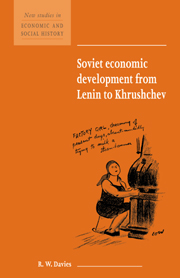Book contents
- Frontmatter
- Contents
- List of maps
- List of figures
- List of tables
- Acknowledgements
- Main dates in Russian and Soviet history
- Glossary
- Map 1 Republics, cities and major towns of the USSR at the end of the 1930s
- Map 2 Agricultural regions of the USSR (including the Virgin Lands)
- Map 3 Industrial regions of the USSR
- 1 Introduction
- 2 The Tsarist economy
- 3 War Communism, 1918–1920
- 4 The New Economic Policy of the 1920s
- 5 Measuring Soviet economic growth
- 6 Soviet economic development, 1928–1965
- 7 The Soviet economic system, 1928–1965
- 8 Soviet industrialisation in perspective
- Further reading
- References
- Index
- Cambridge Cultural Social Studies
5 - Measuring Soviet economic growth
Published online by Cambridge University Press: 06 January 2010
- Frontmatter
- Contents
- List of maps
- List of figures
- List of tables
- Acknowledgements
- Main dates in Russian and Soviet history
- Glossary
- Map 1 Republics, cities and major towns of the USSR at the end of the 1930s
- Map 2 Agricultural regions of the USSR (including the Virgin Lands)
- Map 3 Industrial regions of the USSR
- 1 Introduction
- 2 The Tsarist economy
- 3 War Communism, 1918–1920
- 4 The New Economic Policy of the 1920s
- 5 Measuring Soviet economic growth
- 6 Soviet economic development, 1928–1965
- 7 The Soviet economic system, 1928–1965
- 8 Soviet industrialisation in perspective
- Further reading
- References
- Index
- Cambridge Cultural Social Studies
Summary
The rapid pace of social and economic change in the crucial decades from 1928 to 1965 is inherently difficult to capture in the statistics. At the time of the 1926 population census, the urban population amounted to only 16 per cent of the total; by the time of the 1939 census, the proportion had doubled, to 33 per cent. The first census after the Second World War, in 1959, recorded that the urban population had reached 48 per cent of the total; and for 1965 it was estimated at 53 per cent. In the period 1928– 65 the number of people employed in industry, construction and transport increased nearly sixfold, from 6,554,000 to 38,932,000. By 1965, according to a careful Western estimate, industrial production was fourteen times as great as in 1928; and even the sceptical Russian economist Khanin estimated that it was eleven times as great (see table 10, p. 82; for Khanin's estimate see Harrison 1993, p. 147). Such a rate of social change and industrial expansion, achieved in spite of the destruction of industrial capacity brought about by the German invasion of 1941–5, was without precedent at that time (though it has since been equalled or exceeded by several Asian countries).
During this period the composition of industrial production changed even more radically. In 1928, the machine-building industry was unsophisticated and fairly small. As early as the mid- 19308, it was the most important single industry, and its output included complex machine-tools, iron and steel-making equipment, tanks and many other products which it had not manufactured at all in 1928 (armaments in Soviet statistics were treated as part of machine-building).
- Type
- Chapter
- Information
- Soviet Economic Development from Lenin to Khrushchev , pp. 38 - 42Publisher: Cambridge University PressPrint publication year: 1998



